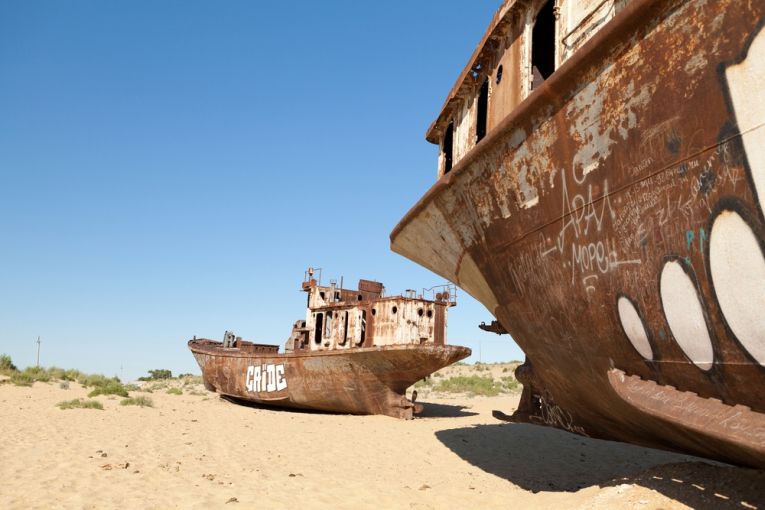The Aral Sea is dead. None of its original rich variety of fish species have survived. The greatly-reduced area has many sites such as this near Munyak in the autonomous republic of Karakalpakstan, with the livelihoods of people destroyed, as their boats are left on the toxic sand-salt; Aral Sea image; Credit: © Shutterstock
To eliminate ecological problems as large as the drying up of a sea is difficult. The problems balloon out of proportion as the effects on landscape, agriculture, and even airborne pollution become obvious. In the case of the Aral Sea in Central Asia, neglect has also contributed. When 2 rivers were diverted to increase profits from the large Soviet cotton agribusiness, when local people first began having severe health problems, then was the time to ease the problem.
By now Uzbekistan, and other former Soviet republics around the diminished and lifeless sea, are in desperate need of international action on this disaster. The effects over the whole region have been recorded in detail to European Commissioners and UN representatives. In New York, now Ban Ki Moon, the UN Secretary General is faced with decisions on a programme to ease the strife and correct a whole set of problems. He had visited the Aral Sea in 2010 with his conclusions at the time mentioning this as "one of the worst environmental disasters in the world," needing to involve the whole world rather than simply the countries of Central Asia. The "Sustaining Livelihoods Affected by the Aral Sea Disaster" programme was effected from 2012-2015, costing 4 million dollars.
In general, the UNDP have helped the Uzbeks to improve some health aspects of the Aral pollutions.
Part of this is due to 8 Millenium Goals, introduced relatively recently in the country. Child mortality more than halved between the millennium and 2011, but children's health remains a major problem around the Aral Sea. On a national level, Uzbekistan takes measures to combat the negative impacts of drying of the Aral Sea.
Hundreds of programs and projects have been realized since early 1990s. A 1.3 billion-dollar-plan to finance projects and measures in the Aral Sea region had been approved for 2013, providing for the creation of small local bodies of water in the Amu Darya delta, construction of water intake facilities with desalination installations, the creation of protective forest plantations and monitoring of the bird life around bodies of water in the southern part of the region.
These programmes demand attention continuously after the years of neglect. Despite appeals, direct threats to the sustainability of life in the whole region exist. There remains not only the sand-salt Aralkum desert's expansion to 5.5 million hectares, but also health effects on the whole of Central Asia posing vital problems. With 755 million tonnes of toxic dust arising in giant clouds from the Aralkum, dust plumes cause effects in the Pamir and Tien Shan Mountains and even the Arctic. The effect on water is incredibly long-reaching, with many severe health effects on children and adults, including dioxin poisoning from previous Soviet agricultural practices.










